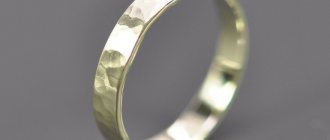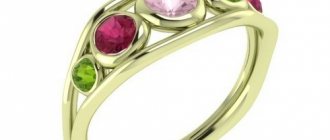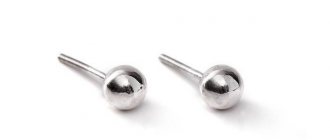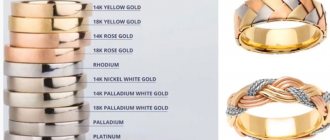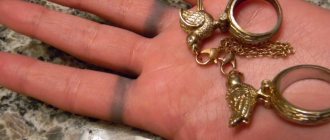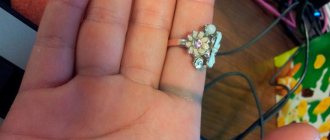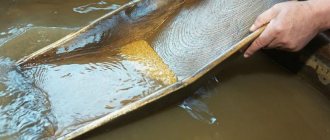Origin of green gold
Green gold became known several thousand years ago. For example, the ancient civilization that lived on the island of Crete used this material to make jewelry, various items for religious rituals, as well as for everyday purposes.
When this ore was discovered several thousand years ago, people called it electrum. This is an alloy of different metals: gold, silver; the percentage of gold in the alloy could be no more than 40%.
In ancient Lydia, such gold was very popular. One of the rulers of this people used electrum to mint coins that had a specific greenish color. If we talk about the time frame, then this is approximately the 6th century BC. e.
Later, the technology for producing green gold in unnatural conditions was lost. Scientists came up with the idea of reviving the green alloy back in the 19th century. Since that time, many variations of this precious alloy have been created, differing in the admixture of various metals.
What is green gold?
Green gold is an alloy of 750 and 585 gold with an admixture of various components, for example, cadmium. It is the inclusion of cadmium that gives green gold jewelry its unique, rich green color. But it is precisely this alloy that will be toxic. Cadmium causes severe allergic reactions and is prohibited for use in jewelry in Eurozone countries.
In the Russian Federation, a ban on the use of cadmium was issued in 2000; in other countries, such as Guatemala, this substance is officially permitted and can be added to green gold.
When inhaling cadmium fumes, a person may stop breathing, and there is a very real threat of death. For this reason, using cadmium in the jewelry making process itself is very dangerous. And if you wear it constantly, it can accumulate in the body.
TOP 3 gold cleaning methods
There are many methods for purifying precious metal. Each of them is suitable for specific purposes and types of jewelry. To summarize, we will compile the Top 3 methods for cleaning gold.
The fastest way
For those who do not want or cannot spend a lot of time cleaning their jewelry, the fastest method will be useful. This is a cleansing using ammonia and hydrogen peroxide. Taking into account the time for soaking the product, cleaning will take 25-30 minutes.
The method from the professional category will be even faster. This is ultrasonic cleaning, because it only takes 2-5 minutes to put the metal in order, and the device will do everything for you.
Most effective
The title of the most effective cleaning method is given to professional devices, as well as cleaning in a jewelry store. Their effectiveness is undeniable, because special formulations have been tested for a long time and their quality is guaranteed. In addition, they take into account all the features of the products for which they are intended. Cleaning in a jewelry salon is also quite objectively placed in this category. After all, the master will competently select the type of cleaning. In addition, he has professional tools at his disposal.
Green gold composition
There are a huge number of alloys that look similar to green gold, which characteristics correspond to high-quality jewelry.
- The ring or earrings do not oxidize.
- Do not react with oxygen and acids.
- The structure of the metal is quite hard and at the same time plastic.
- The decoration does not cause allergies.
It is the composition of the ligature that determines the color of gold. To give gold a green color, the following is added in different proportions:
- silver;
- copper;
- zinc;
- potassium;
- nickel;
- cadmium and rubidium.
It is the last two elements that make green gold jewelry toxic. By the way, in the European Union countries there is also a ban on the use of nickel in gold jewelry. This metal brightens the alloy and is often added to smelt white gold.
Main causes of the defect
As already mentioned, gold is a noble metal and has valuable qualities, which, however, do not save in some cases. It happens that gold turns black, losing its color and shine, or gold leaves black marks on the skin. Such unpleasant consequences do not mean at all that the metal has lost its properties. Often the reason for this is an external factor, which is initially controlled by the owner of the jewelry. But there are exceptions that you should also be aware of.
Why does gold darken?
- Ligature. Since pure gold is never used in the manufacture of gold products, certain impurities are required to enhance wear resistance. This is usually silver, palladium or copper. Jewelry workshops try to reduce the cost of the production process by using other additives, which leads not only to a decrease in the quality of the product, but also to the fact that gold loses its properties in a very short time. In such cases, it is recommended to immediately return the item to the jewelry store and request a refund or replacement.
- Natural body secretions. The human body constantly releases various substances that are the result of vital activity. Many of them have a rather negative effect on gold. Jewelry, even those worn in the ears and barely in contact with the skin (except for the clasp), can darken. Gold has darkened - this does not mean that its composition necessarily contains low-quality impurities. This means that it needs to be cleaned regularly, removing the layer of plaque so that oxidation does not become critical.
- Another reason, which concerns mainly the fair sex, is the frequent use of various cosmetics that contain various compounds of mercury and iodine. This is a rather unpleasant option, since in this case gray stains appear on the gold jewelry that cannot be removed.
Pay attention to how other jewelry behaves - perhaps the reason lies precisely in your wearing style.
Methods for removing plaque
If plaque can still be removed, this should be done with caution, since if not gold, then some types of soft stones can be easily damaged by various alcohol or alkaline solutions.
It is quite possible to clean gold at home. This will only require you to pay attention to the conditions for caring for certain components of the product.
If your decoration does not include any soft elements, you can safely prepare a solution that consists of:
- ammonia;
- liquid soap.
Green gold - features of the alloy
In order for green gold to acquire a rich color, you need to use a lot of alloys, including toxic metals. And to create a pleasant and delicate greenish tint, you need to add to the alloy: silver, potassium, nickel, zinc, and copper. At the same time, the percentage of gold remains stable from 58 to 70%.
Green gold is brittle, breaks quite easily and is very difficult to process. It can be perfectly combined as a secondary material to the main material. To obtain a durable alloy, you need to add silver in a certain proportion.
Cleaning at home
All recipes based on soap solution will give a guaranteed result. Wash the jewelry in a soapy solution, and then use sodium hyposulfite (20 g) and water (100 g). Sodium hyposulfite or sodium thiosulfate has a wide range of uses. In the case of cleaning jewelry, it acts as an antibacterial and antimicrobial substance, which allows you to effectively clean the jewelry.
Cleaning gold with ammonia
As with white gold, the ammonia contained in ammonia will react with the oxidizing agent and cleanse the gold of impurities and stains without damaging the metal itself. This method is universal for all types of gold.
Compound:
- water (1 glass);
- ammonia (1 teaspoon);
- washing powder (1 teaspoon).
Procedure:
Bring water to a boil, add powder and alcohol. Leave in the solution for 2-3 hours. Rinse with water and dry with a soft towel.
Cleaning gold with ammonia and peroxide
This method is effective for persistent and severe stains and darkening. Peroxide is an oxidizing agent with which ammonia contained in ammonia reacts. The reaction between them gives a more intense effect on pollution.
Compound:
- ammonia (1 teaspoon);
- hydrogen peroxide (1 teaspoon);
- water (enough to immerse jewelry);
- liquid soap.
Procedure:
Bring water to a boil, pour in liquid soap and ammonia with peroxide. Leave the jewelry in the composition for 20 minutes, wash and dry.
Cleaning gold with foil
Compound:
- water;
- baking soda (2 teaspoons);
- foil.
Procedure:
Place a piece of foil at the bottom of the cup, lay out the products and fill with the prepared mixture. Let sit overnight, then rinse and dry.
The method should not be applied to products with stones, especially pearls.
Cleaning gold with Coca-Cola
Despite the fact that cola is a food product, it will do an excellent job of removing stains on jewelry. To do this you will need a small amount of drink and your products. Leave them in Cola overnight and enjoy the effect.
Cleaning gold with Vaseline
To manually wash gold from blackness or stains that have appeared, you can use Vaseline.
Compound:
- petrolatum;
- chalk (powder);
- bar soap (grind into shavings);
- water.
Mix all ingredients until smooth. Then blot the entire surface of the product and leave for 10-15 minutes. Rinse and dry. This method will not only help remove plaque from gold, but also add shine.
This method is more effective due to the physical impact on the product. Vaseline in this case will act as a binder, which will help achieve the consistency of a paste. Soap and chalk will perform the function of gently cleaning and polishing the metal.
Cleaning brown
Borax is capable of dissolving proteins and fats, and also has strong bactericidal properties; it is also used to remove mold. Ammonia also has antibacterial, cleansing and bleaching properties. In combination, these substances give a quick cleansing effect.
- water (0.5 liters)
- ammonia 10% (5 g)
- borax (15 g)
Mix all the ingredients and wipe the accessory with a cloth soaked in the composition. Rinse with water and dry.
Be careful when using borax, it is a poisonous substance. This method should not be used on cutlery.
Cleaning with chalk
This method is effective, since the ammonia contained in ammonia affects the product, reacting with it. It cleanses it of dirt and darkening. Tooth powder performs the function of polishing and adding shine.
Grind up the chalk and rub it on the decoration. Rinse with water and dry. You can also prepare the composition:
- tooth powder (15 g);
- ammonia (30 g);
- water (50 ml).
Mix all the ingredients and rub the product with the composition. It is important that the water is cool. Rinse and dry.
Cleansing with wine or beer
Wine alcohol or beer will effectively clean medical alloy products. Soak a soft cloth in the liquid and wipe the jewelry with it. Leave on for 5 minutes, rinse and dry.
Shades and hallmarks of green gold
There are three main shades of green gold: rich, delicate greenish and light. The most popular shade is light green. Many believe that it gives the decoration uniqueness and some mystery. As mentioned above, green gold exists in 2 samples - 585 and 750.
Shades
In addition to the popular light green shade, you can find green gold with a yellow tint. It should be remembered that the more impurities in the alloy itself, the greater the contrast you will be able to see.
Using large amounts of copper in green gold is also harmful. The more copper a jeweler adds to gold, the more fragile it becomes.
The influence of alloying components on the hardness and strength of the alloy
Copper, platinum, palladium and nickel are the main elements that form solid solutions with gold. They give the alloy hardness and higher strength.
Shlychkova V.S. and Starchenko I.P. in their article about alloying additives in gold note: the more the atomic radius of gold and impurities differ from each other, the more durable the alloy becomes. For example, adding 50 at.% silver to gold almost does not change its hardness, while 50 at.% nickel increases the hardness of gold by almost 15 times!
Changes in the strength of gold when alloying it with various elements
Depending on the density of its constituents, a gold alloy can be hard and durable, or hard and brittle.
The impurities in gold of tin, sulfur, antimony and bismuth are harmful to the alloy as they make it very brittle!
How to recognize toxic gold
In ancient times, people also knew about the bad effects of cadmium on the body, for this reason its share in gold was a small part. However, if you wear the products for a long time, cadmium will accumulate in the body, which will lead to dire consequences.
When the harmful effects of cadmium were officially proven, many states in the world banned the use of it for the manufacture of any jewelry. In the Russian Federation, such a ban was established back in 2000. Since then, original and safe green gold jewelry has been marked with two hallmarks.
- ZlSr 585-415 (pronounced green color of the product).
- ZlSrM 585-300 (yellow gold with a faint green tint).
If you do not find markings on the jewelry, you should refuse to purchase such products, because hazardous metals were used in their manufacture.
What to do and what not to do if rust is found on gold
If you find spots on gold that look like rust, you should not rush to wash or wash them, as this can damage the product or coin. It is better to contact a jeweler who will professionally carry out restoration of problem areas. Bankers assess the possibility of such defects as a minor problem. The repurchase of such coins by banks comes with a slight discount.
The high inertness of gold does not mean that it cannot become contaminated and cause problems.
- For example, iodine, getting on the surface of the product, will destroy the outer layer, creating a grayish color. This is dangerous when the jewelry is coated with a thin protective layer of rhodium or ruthenium.
- Caution does not hurt when using household chemicals, cosmetics, perfumes, and medicines.
- The characteristics of a particular person's skin and perspiration can lead to discoloration of precious metal products.
What other colors of gold are there?
Brown gold
The father of brown gold is considered to be the jeweler and chemist Fawaz Gruosi. He is known throughout the world as a high-level experimenter who carefully keeps his secrets for making this gold.
There is a theory that such gold could be obtained by combining red and pink gold of various samples with manganese, nickel and iron. It is more common to find a brown tint in the inlay of expensive watches than on ordinary jewelry.
Purple gold
This gold can be obtained by mixing it with aluminum. But it is not widely used due to its fragility; it is used as a surface coating for jewelry. All about purple gold, see photos of jewelry here...
Blue gold
Gold is also quite rare; the production of blue gold is unreasonably expensive. To obtain this shade of the alloy, gold, indium, and cobalt are mixed.
Black gold
Black gold is obtained by mixing gold with cobalt or chromium. This process is so complex that finding good quality black gold is a great success. For this reason, instead of black gold, they may sell you white gold, which is plated with black rhodium.
Green gold jewelry
In Russia, this type of gold is not widespread and is not popular. This is due to stereotypes that originated in the Soviet Union. Other colors of gold, such as white, are common only in jewelry and are not highly valued. In most of our jewelry, you can find green gold as an additional material.
Green gold price
Green gold costs the same as regular or white gold. You can also find more expensive options - these are designer jewelry from world brands.
If you look at the samples, then 1 gram of 750 sample will cost approximately 2000 rubles, the scrap value is 1800. If you count it as part of a piece of jewelry, the price will be approximately 4500. But 585 sample will be much cheaper, and will be 1100 rubles.
Effect of impurities on the melting point of gold
The melting point of gold is important for jewelers. When making jewelry, craftsmen try to use more fusible impurities. After all, if gold melts for too long, it slows down and complicates the work of the master.
The melting point of the most popular 585-carat gold ranges from 880°C to 1280°C. The melting point closest to this indicator is copper (1083°C) and silver (962°C). But palladium is a more refractory element with a coefficient of 1554°C.
The appearance of ready-made ligatures greatly simplified the process of creating jewelry. They already contain all the elements in the required proportions to obtain a certain sample and color. Some give it the necessary plasticity for handwork, rolling and drawing gold wire, while others give it fluidity (for precision casting using lost-wax openwork models).
Green gold - how to distinguish from fakes
The problem of fake gold jewelry in the Russian Federation is very common, and many unscrupulous jewelers are trying to sell fakes instead of green gold. This is explained by the fact that the consumer is little familiar with this metal and is easy to deceive. According to official statistics, approximately 4 out of 10 products are fake green gold. To avoid being deceived, pay attention to the following.
Decoration color . Products of a rich green color are fake or smuggled, which is much worse for health, since in Russia it is prohibited to use toxic elements that give this rich color to green gold. The color should be delicate and light.
Labeling . The jewelry must be marked with either 750 or 585 standard. There simply shouldn't be others.
Sustainability . You can try rubbing the products with iodine or alcohol. Fake gold will tarnish and lose its color very quickly.
Reaction with a magnet . Products should not stick strongly to the magnet. Otherwise, a completely different number of components were added to the alloy.
Weight . It is worth noting that fake green gold is very light. But an ordinary person may not notice this flaw. Before purchasing, be sure to consult with a competent and honest specialist.
It is best to buy green gold products only from trusted jewelers who can guarantee you quality not only in words, but in documents.
If there are stones
To quickly and effectively clean gold jewelry with a stone at home, you should follow some rules. They are applicable to any stones, but mainly to soft ones.
- You should not resort to using methods that involve the use of vinegar and ammonia. These components can negatively affect the condition of the stone; it will stop sparkling or change shade.
- Do not use abrasive cleaning agents (powders, acids)
- Polish only with lint-free cloths (towels) or flannel cloths
- Do not soak in water or soap solutions for longer than 20-30 minutes.
The most favorable composition for cleaning jewelry decorated with stones is alcohol. To restore its shine, it is immersed in an alcohol solution for 20 minutes. It will have a beneficial effect on the precious metal and cleanse the stone.
Cleaning gold with stones (read)
Products with diamonds or other hard stones
If we are talking about jewelry, for example, with diamonds or cubic zirconia, then any methods where the main component is ammonia are suitable. It should be used when it comes to dirt, darkening, or lack of shine. After the procedure, do not forget to wipe the jewelry with a soft cloth. If you just want to refresh the product, a soap solution will be enough.
